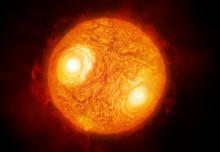Listen to today's episode of StarDate on the web the same day it airs in high-quality streaming audio without any extra ads or announcements. Choose a $8 one-month pass, or listen every day for a year for just $30.
You are here
Moon and Companions
Stars are all glowing balls of gas that “fuse” lighter elements to make heavier ones. Within that broad description, though, there’s a huge diversity of size, mass, brightness, and temperature.
A star at the top end of the scale is in good view tonight. Antares is the heart of the scorpion. It’s below the Moon as night falls, shining bright orange.
The least-impressive stars are only about one-tenth as massive as the Sun, and just one ten-thousandth as bright. But they make up for their puniness with longevity — they’ll live for a trillion years or longer — a hundred times the current age of the universe.
Stars like Antares, on the other hand, burn through their nuclear fuel in a hurry. Antares is about 15 to 18 times as massive as the Sun — one of the heaviest stars around. Because of that great mass, though, gravity squeezes its core tightly, greatly revving up the rate of nuclear reactions. So Antares will live only about 20 million years — the blink of an eye on the astronomical time scale.
Antares is more than half way through that lifetime, so its surface layers have puffed up to enormous proportions — the star is almost a thousand times wider than the Sun. And it produces tens of thousands of times more energy than the Sun — a true standout among the stars.
Again, look for Antares below the Moon this evening. Brighter Saturn is about the same distance to the left of the Moon. More about the Moon and Saturn tomorrow.
Script by Damond Benningfield




